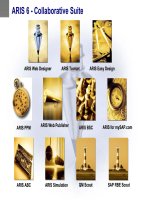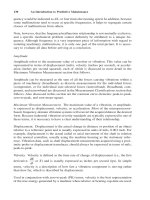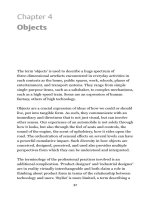Introduction to XSLT Concepts phần 4 pdf
Bạn đang xem bản rút gọn của tài liệu. Xem và tải ngay bản đầy đủ của tài liệu tại đây (173.98 KB, 10 trang )
Introduction to XSLT Concepts
slide 46
Single Source and Reuse Publishing
(XSLT fulfills the XML promise of multiple use)
C
Making the output product
C
preparation for publishing (web and print)
C
Print on Demand and web serving
C
composition drivers
C
QA and proofing
C
XML to XML transform
C
XSLT as the middle component in XSL-FO
slide 47
Construct the Output for Publishing
(transformations build products)
C Out of databases, rearranged for the web
C Customized printing = Different users get
C different order
C different text or content
C same content different look-and-feel
C Print on Demand (with data up to this minute)
Page 25
Introduction to XSLT Concepts
slide 48
What You Want in the Order You Want It
Select / Extract / List / Omit
C
Pull out the metadata to put into the catalog
C
Extract titles and abstracts of all articles for the advertising webpage
C
Extract the CME material for a special site for nurses
C
Get all the environmental impact material
C
Publish this report with all the SECRET material removed
C
Get me the citations to send to the link matching service
C
My car has a sun-roof, manual transmission, and option package #4,
make me my owners manual
C
Get me all the dosage sections that mention pregnancy restrictions
slide 49
There is Not Just
One
Print Product
C Customization (change, assemble, or adapt
based on customer or organization)
C mix and match text and graphic components
C target specific markets
C Personalization (tailor a product to an individual person)
C based on purchase, profile, history
C Internationalization (multiple languages, script, writing directions,
currency)
C Localization (adapting a print product to a specific locality/region)
Page 26
Introduction to XSLT Concepts
slide 50
Some of the Text is Added by the Transform
(textual additions are called “generated” text)
Text that is not in the data, but is put in by the transform,
based on the tagging
For example:
C
numbers or bullets that prefix list items (1., 2., 3.)
(based on <list-item> tag)
C
mark a footnote reference (²) or a citation reference [Lapeyre, 2006]
based on a cross-reference made with an attribute
C
Adding words or phrases to titles (Chapter VI Sassy Poodles)
C
Turning a cross reference into text
C
<xref redid=:A123456"/> into
C
“See Figure 6, Herpetologist Distribution Curve”
Less content maintenance!
slide 51
Large Structures Can be Built and Inserted as Well
C Table of Contents from chapter titles
C Subject index from embedded index terms
C List of Figures, Tables, Equations, Genus-species names
C Title Page from the metadata elements
C Leaning Objectives from embedded objectives
Page 27
Introduction to XSLT Concepts
slide 52
XSLT is Also Useful During Production
Transformations for Editorial QA and Proofing
C
Make checklists for humans to examine
C
Make files for automated authority checking
C
Run galleys as often as you want
C
Make useful displays that will never be printed
C
number things that won’t be numbered on display
C
if the book will say“(See Section 4.3)”
put the section title into the reference
“(See Section 4.3 My Life with Poodles)”
C
make false color proofs
C
ferrous materials in red and non-ferrous in green
C
all skeletal system paragraphs in blue, circulatory system
paragraphs in red
C a citation with author name in green, journal name in pink, year in
blue, paper title in yellow
Page 28
Introduction to XSLT Concepts
slide 53
False Color Proof
Water is blue (italic), land is yellow (bold), and “features” are purpley
(display font in the print)
Page 29
Introduction to XSLT Concepts
slide 54
XML for Interchange and Archiving
XML to XML Transforms
C
Corporate tagset into
C
client’s tags
C
business partner’s tags
C
Company-specific tags into Industry Standard schema
C
5 Publisher tag sets into one repository / aggregator tag set
C
Authoring DTD into publication DTD
C
50 articles to one RSS feed of the summaries
slide 55
XSLT as the Middle Component in XSL-FO
C XSL is a spec with two parts
C XSLT (the transformation part)
C XSL-FO (the formatting part)
C XSL provides a tag set into which XML documents
may be transformed (using XSLT)
C describes page geometry
C says how to put content on the page
XSL-FO used to make PDF (or RTF or MIF) directly from XML
Page 30
Introduction to XSLT Concepts
slide 56
How XSL-FO Works
C
XSLT
C
transforms the input
C
makes a tree of formatting objects
C
An XSL-FO document is
C
an XML document
C
with text and graphic content wrapped in formatting object tags
C
XSL-FO (XSL Formatting Objects)
C
get processed by a rendering engine (software)
C
to make an output file
C
a display engine (like a browser or a printer)
makes the pretty output
slide 57
Remember How an XSLT System Works
Page 31
Result
Tree
Source
Tree
T
r
a
n
s
f
o
r
m
e
r
<z>XSL is <e>fun</e></z>
<t>XSL is </t>"fun"
<xsl:stylesheet>
</xsl:stylesheet>
Introduction to XSLT Concepts
slide 58
Architecture of a Full XSL System
(XSLT + XSL-FO)
slide 59
Formatting Objects Describe Page Layout
C Page layout:
C page size, margins, columns
C headers, footers, side-bars. etc.
C Different page layout templates (
masters
) can be sequenced, e.g.
C first page followed by later pages
C recto / verso alternating
C XSL-FO properties control hyphenation, widows / orphans, etc.
Page 32
Result
Tree
Source
Tree
T
r
a
n
s
f
o
r
m
e
r
F
o
r
m
a
t
t
e
r
<z>XSL is <e>fun</e></z>
XSL is fun
<xsl:stylesheet>
</xsl:stylesheet>
Introduction to XSLT Concepts
slide 60
Applying Styles through XSL FOs
slide 61
XSL-FO is a Great Report Writer
(Pagination is not a problem)
C Credit card and bank statements
C Investment portfolios
C Hospital systems reports
C Insurance policies and claims
C Patient medical charts
C Directory products
C product and editorial indicies
C company personnel listing
Page 33
Introduction to XSLT Concepts
slide 62
The Last Bits
C
Other things you need to know about how XSLT works
C
XPath for tree-walking
C
Pull-style stylesheets
C
XSLT 2.0 (with XPath 2.0)
C
How can you make yourself (or your staff) into XSLT people
slide 63
There’s Another Part of XSLT
We Haven’t Talked About
XPath
Really powerful!
slide 64
What is XPath
C The tree-walking part of XSLT
C So named because it uses a path notation with slashes
like UNIX directories and URLs
play/act/scecne/speech
invoice/customer_data/customer_name
C XPath 1.0 W3C Recommendation in 1999
C XPath 2.0 W3C Recommendation Draft 2005
(more complex, more powerful, harder to learn)
Page 34









